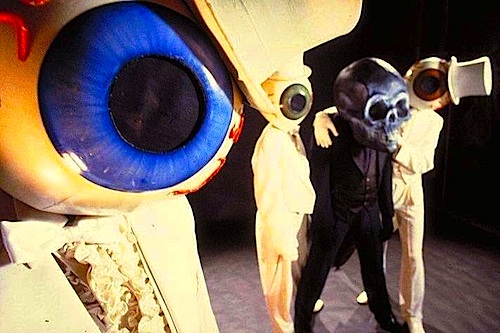By Joe Bendel. They were influenced by Sun Ra and toured with Penn Jillette. Few bands command the same degree of fan loyalty and fascination, but it is important to note The Residents might not actually exist. Fortunately, that will not deter Don Hardy from chronicling their careers in The Theory of Obscurity: a Film about the Residents, which screens during this year’s SXSW Film Festival.
The identity of the musicians beneath the eyeballs remains of the most closely guard secrets in show business. Right from the start, Hardy warns the audience everything fans think they know about the band might be false. Of course, the Residents are not about to set the record straight. After forty years of strict anonymity, they are not about to embrace the trappings of celebrity culture now.
They fact remains, nobody outside of the band’s most intimate circles know who is a member or what they look like. Reportedly, they originally hailed from Northern Louisiana, but made their way to San Francisco, for obvious reasons. The quartet (as far as we know) were just as interested in avant-garde art as music, incorporating both into their program. They adopted their tongue-in-cheek name and trade mark eyeball masks and top hat ensembles largely through unlikely happenstance, but the group’s interest in new technology and short form video put the Residents decades ahead of their contemporaries. It boggles the mind today, but there was a time when the Residents were in heavy rotation on MTV, which Hardy hastens to explain to young viewers was once the broadcast home of music videos.
It must be constitutionally impossible to make a dull film about the Residents, but if you are expecting a dramatic Scooby-Doo style reveal at the end, forget about it (however, there is an amusing stinger worth staying for). However, it sometimes feels like Hardy is too respectful of his subjects, never presuming to speculate about anything concealed by their costumes and myth-making, even though he has us well primed for some idle conjecture.
Still, even if you have yet to acquire a taste for their darkly hued, often discordant music, it is cool to see they never succumbed to the lure of fame and the ego-stroking that typically goes with it. They just keep doing their thing. That necessarily means Hardy had no interviews with his subjects, which presents an undeniable challenge. Nevertheless, he scored sit downs with former members of the Residents inner circle, including several former officers of The Cryptic Corporation, the band’s duly empowered business and logistical management crew, as well as Jillette, the intentionally over the top emcee of their notorious early 1980s tour.

That Hardy leaves all of the Residents’ secrets undisturbed is both laudable and frustrating, because let’s face it, the group inspires a virulent form of curiosity. It is not called mystique for nothing. We wonder just who played the Albert-Ayler-on-crack alto solos during their early performances and whether there has been any personnel turnover throughout the decades. Naturally, that mystery is a good part of the band’s allure. Hardy illuminates their appeal and cogently puts their work in the cultural context of the times. Recommended for Residents fans and those who appreciate a little eccentricity in life, The Theory of Obscurity screens again this Thursday (3/19) and Friday (3/20) as part of the 2015 SXSW.
LFM GRADE: B
Posted on March 17th, 2015 at 10:20pm.